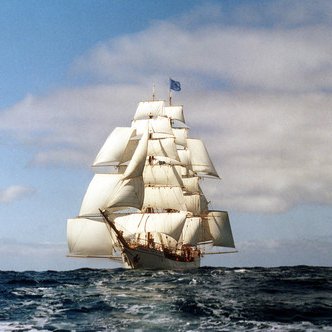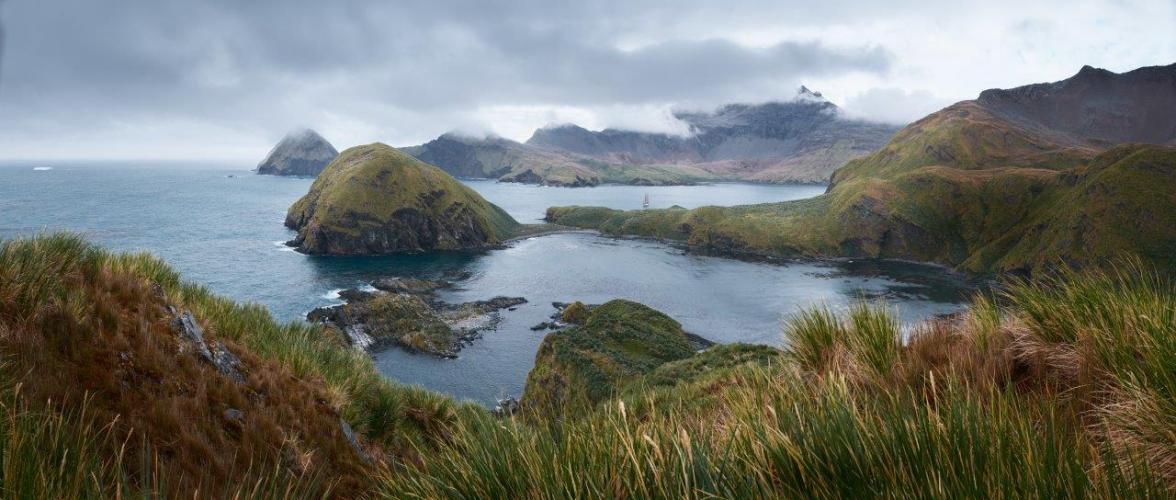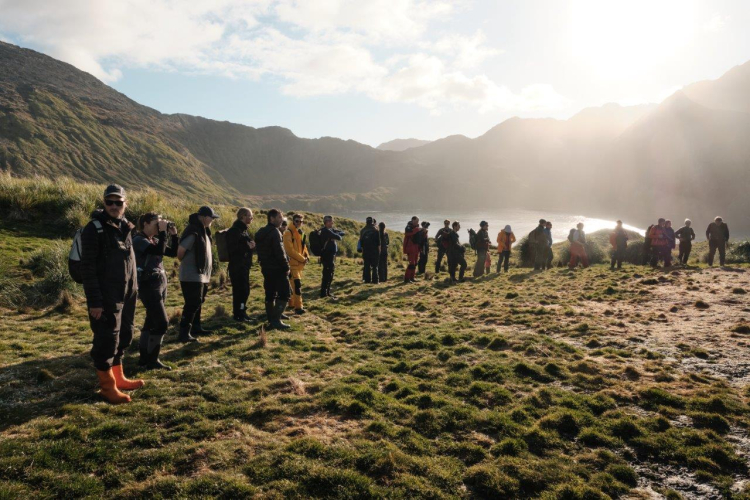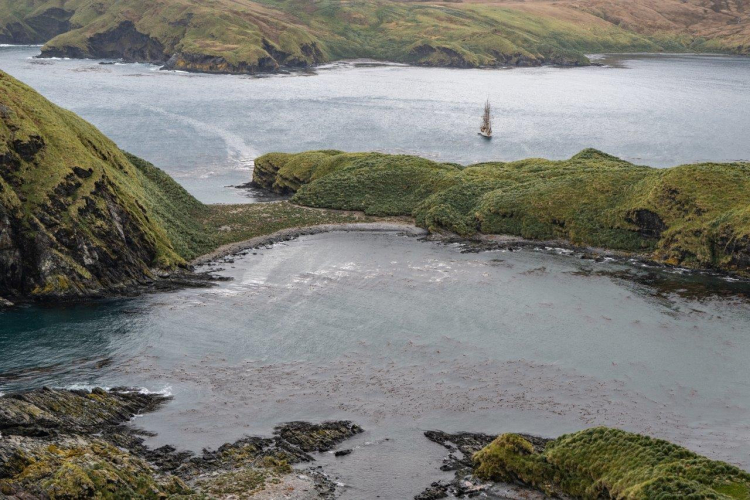Cobblers Cove walk to Rookery Point in the morning and Godthul in the afternoon
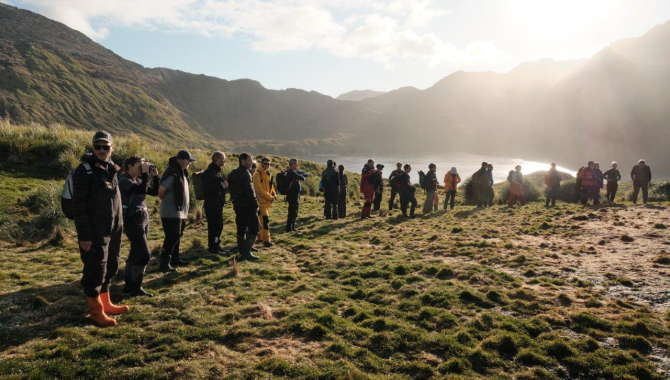
EUROPA remains at anchor at the entrance of Godthul Bay from last night and for the whole of the day. The activities for today, both morning and afternoon can be done from this relatively small but sheltered anchorage.
Northerly winds and swell hit the open coastline, while inside the bay the conditions are better.
A combination of two zodiac rides with a small peninsula crossing by foot in-between, brought us to Cobblers Cove, named after the numerous White chinned petrels that nest here. This species nickname: Shoemakers or Cobblers, is because of their noise around their burrows, similar to that of an old-fashioned cobbler’s sewing machine). The secluded cove is one of the most sheltered ones for small vessels and sailing yachts, though a bit of a challenging site for a ship like EUROPA. The entrance to Cobblers runs through a dramatic little channel between cliffs up to 100m high on one side and shoals and rocks covered with Kelp on the other, leading to the landlocked cove.
If you manage to get inside, you are usually welcomed by calm waters despite the surge and breaking swell over the outer shores.
But today the northerly swell and wind blows straight into it. Nothing not manageable for small rubber boats though. Once you find yourself into Cobblers you are surrounded by steep mountain slopes at all sides, while at one side it is possible to climb up to a saddle 150m above sea level, the gate towards the rocky and exposed coast of the island, where our goal is located, Rookery Point and its colony of Macaroni penguins.
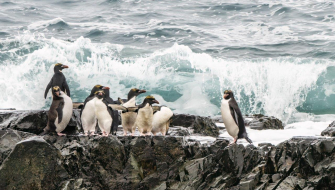
Up the hills the views are fantastic. To one side the pocket bay of Cobblers is left gradually under our feet and at the background the larger Godthul bay extends, with the ship at anchor nearby. To the other, gentler terrain descends to the sea.
In the past, before the successful Habitat Restoration Project was conducted, a heard of Reindeer use to graze on those grass covered slopes. Nowadays, with all of them eradicated, just scattered bones lay here and there.
The walk becomes easier, now downhill until reaching sea level again, and there, half hidden in the tussock grass, is the place where the Macaronies nest. For their comings and goings to and from the sea, they always choose the most difficult corners, where often the waves smash against the cliffs. Still it is possible to reach this area, if you manage to cross a bit of the infamous Tussock grass. There, over a large rocky slab some of them rest, some chose this exposed spot to moult too, others jump off the breakers onto land. A sight like no other.
Soon it is time to head back to the ship, again an operation involving quite a hike and two different zodiac shuttles.
The afternoon landing is just on the other side of the bay. Situated 9km east of Cumberland Bay on eastern shores of Barff Peninsula. Godthul is a 3km long inlet that lies between Cape George and Long Point. Gentoo penguins are abundant with a colony located up in the headland, beach and tussock grass are filled with seals. Structure of a small shore depot contrasted with saturated green color of that tussock grass that has overgrown the remains of old whaling boats complexly. Rusty barrels, wooden shed and the boats are fascinating relics of the whaling era. Another testament to a whaling history to this place are large number of whale bones scattered all across the beach.
Whaling operations began on the 8th January 1908 when the whaling factory ship Aviemore accompanied by two catcher vessels Edda and Snore anchored in the harbour. The vessel belonged to the Bryde & Dahl Hvalfangerselskab Company in Sadenfjord, Norway. The company established a floating factory operation which included a small shore base with a storage shed, three small oil tanks, and depot of wooden and metal barrels. A dam was built at the nearby lake to provide a reliable supply of fresh water. Wooden boats called jolla were used as a platforms for fleshing whales alongside the factory ship.
Although not a long landing, this proved to be a challenging one. Cobble-stoned beach just next to the whaling remains offered good and fairly sheltered landing. It is only a few meters wide but yet again full of seal pups, penguins and occasional petrels. Tussock grass just behind the beach and also on the slopes of headlands gave cover and good resting place to hundreds of seals. Some elephant seals also found refuge in the grass resting and bathing in warm sunlight. We started to walk passing the relics that we observed rather from a distance due to high number of wildlife around them. And then it was time to face the tussock grass jungle start making our way up on fairly steep slope. It wasn't the easiest. Grass was very dense and the slope quite steep, a setting that was challenging by itself. It took some time and effort to find a way uphill until we reached a higher and easier plateau where the ground was covered with short grass and abundance of moss. From this point, walking was easy, our destination, the Gentoo penguin colony clearly visible in the distance. On the way, few lakes broke the hegemony of grass and swampy surface, reflecting the blue sky in almost windless weather. Surrounded by mountains and cliffs on one side and Godthul bay on the other we walked almost on a virgin land, or at least it felt that way. The penguin colony is split into a few big rookeries and counts with several hundred pairs. Many of them moulting, few still sitting on the nest.
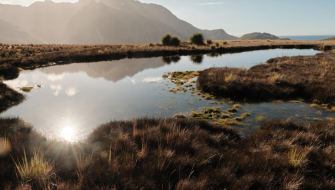
When it was time to leave, there was one more challenge remaining for us, getting down to beach. Again, we had to negotiate a tussock grass field as dense as the one on our way up, albeit less steep. We all made it down to the beach safely, some more muddy then others. The afternoon landing at Godthul proved to be an advanced tussock grass experience, so typical for South Georgia. Tussock is one of the most important ecosystem of the island, and today, we got the full taste of it. Thus far today hikes were the most challenging and offered a full blown experience walking through it.
As the sun dropped closer to horizon, we glanced one last time at the sun-lit landing site we just experienced and hopped into the zodiac. The ride back to the ship was long as the whole experience of today. After hoisting the zodiacs and cleaning we are ready for dinner and well deserved rest. Tomorrow, more exciting landings await us before our South Georgia adventure comes to an end.
